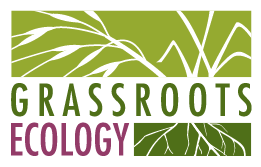
STULSAFT PARK
Stulsaft is a 42-acre city park nestled in the foothills of Redwood City. The park is located within the Redwood Creek watershed, and the perennial Arroyo Ojo de Agua flows through the park and later connects to Redwood Creek in downtown Redwood City. Stulsaft is home to three endangered and threatened plant species: Crystal Springs fountain thistle, Marin dwarf flax, and Franciscan onion. Areas of serpentine soil found throughout the park create unique conditions favoring rare native wildflowers, many of which are endemic to serpentine soil.
Grassroots Ecology has partnered with the City of Redwood City and other organizations to work on invasive plant removal and monitor rare plants at Stulsaft Park since 2007. Our emphasis at Stulsaft Park is to engage and empower local high school students to explore the outdoors, monitor water quality, and improve habitat in the park.
OUR VOLUNTEER PROGRAMS AT STULSAFT PARK
We also host students as a part of Youth Exploring Climate Science with the San Mateo County Office of Sustainability, as well as service-learning events with local schools and nonprofits.
OUR RESTORATION WORK AT STULSAFT PARK
Planting Natives
Our high school students have adopted and designed a restoration plot near the park’s lower entrance that, after being cleared of non-native invasive plants, now hosts a diverse array of native plants, such as California blackberry, bee plant, and hairy honeysuckle.
We have been working with volunteers to create healthy riparian zones along the Arroyo Ojo de Agua by clearing invasive Himalayan blackberry and Algerian ivy and replacing them with native sneezeweed, rushes, and snowberry.
Invasive Removal
Our restoration work at Stulsaft began by providing Kennedy Middle School students with outdoor education experiences. The students studied native trees and creek life and removed ivy, pampas grass, and himalayan blackberry from creek banks. In 2010, we began to remove Arundo, or giant reed, a huge highly invasive grass, from the shrinking habitat of the endangered native Crystal Springs fountain thistle. The thistle has since expanded in number and thrives at the park. We have also been removing French broom from the hillsides, yellow starthistle from areas surrounding the serpentine zone, and assisting the City by identifying invasive shrubs to remove to improve habitat and reduce wildfire danger.
EXPLORE STULSAFT PARK
VISIT STULSAFT PARK
3737 Farmhill Blvd, Redwood City, CA 94062
Stulsaft has four entrances, the main two being on Farm Hill Blvd and at the end of Recreation Way and Goodwin Avenue that brings you to the off leash dog area. There is no parking lot at the park, but there is free street parking nearby. Be sure to lock your car and take all valuables with you. Bus route 274 West has a stop near the park at Emerald Rd, and 274 East has a stop at Farm Hill Blvd, about a half of a mile from the park. The trails in the preserve are unpaved and can be steep at times. Some areas at Stulsaft have little shade so come prepared to explore with water and a hat, and be aware of ticks and poison oak.
OUR TEAM AT STULSAFT PARK
Any questions about our work at Stulsaft Park can be directed to Project Manager Laurel Wee.
OUR PARTNERS
Franklin and Catherine Johnson Foundation










